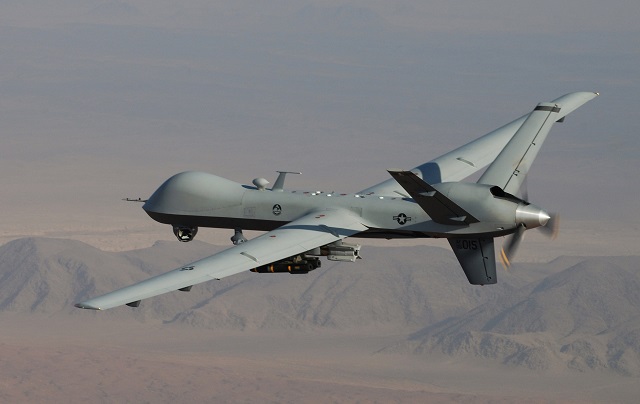
Beijing, China | Xinhua | A U.S. drone strike in late August in the Afghan capital of Kabul supposedly targeting terrorists turned out to have 10 innocent civilians killed instead, including seven children.
Amid a cascade of searing media reports, Commander of U.S. Central Command Kenneth McKenzie on Friday admitted the horrendous incident, noting that it is “unlikely that the vehicle and those who died were associated with ISIS-K, or were a direct threat to U.S. forces.”
The U.S. general called the bloodshed “a tragic mistake,” but obviously that was merely the latest in a slew of such mistakes the United States has made over the past 20 years in its so-called “war on terror,” which features massive innocent civilian casualties caused by its drones.
In fact, Washington’s abuse of remote-controlled pilotless aircraft — which the United States claim to be anti-terror weapons but which have increasingly become “murder weapons” — has once again exposed America’s hegemonic excess.
ASTONISHING CIVILIAN CASUALTIES
On the afternoon of Aug. 29, a Hellfire missile — a precision air-to-ground, subsonic weapon with anti-tank capacity — landed on the courtyard of Zamarai Ahmadi’s home in a northwestern Kabul neighborhood, destroying his white sedan and killing him, two other male adults, and seven children aged between two and 15 years.
The United States later said the airstrike was carried out by its military forces against a suspected vehicle of ISIS-K, an Afghanistan-based offshoot of the Islamic State, which could pose an imminent threat to the Kabul airport.
However, investigations published by The New York Times, The Washington Post, and CNN separately suggest that the U.S. military might have mistaken Ahmadi, a 43-year-old electrical engineer working for California-based charity organization Nutrition and Education International, for a suicide car bomber.
“It was a terrorist attack against our family, and it happened when my brother was parking his car,” Emal Ahmadi, Zamarai’s brother, told Xinhua.
Such tragedies perpetrated by the United States have happened countless times. In December 2013, a U.S. drone strike mistakenly hit a wedding party in Yemen’s southeastern province of al-Bayda, killing up to 11 Yemeni civilians and wounding 21 others. In March 2011, more than 40 people were killed in U.S. drone strikes in Pakistan’s northwest tribal area of North Waziristan.
From January 2004 through February 2020, the United States launched at least 14,040 drone strikes in Pakistan, Afghanistan, Yemen and Somalia, resulting in the deaths of 910 to 2,200 civilians, including 283 to 454 children, according to London-based nonprofit news organization the Bureau of Investigative Journalism.
DISREGARD FOR LIVES
Although it is fully aware that this weapon of choice will bring disaster to the innocent, the United States has nonetheless deployed swarms of drones in foreign battlefields. Its promise to avoid harming civilians rings hollow before its blatant disregard for innocent lives.
Some former U.S. intelligence officials confessed that the U.S. military became overly reliant on signals intelligence to identify and ultimately hunt down targets, though it is hard to guarantee accuracy just with metadata from phones and computers as well as communications intercepts, and that has led to the killings of innocent people in drone strikes.
In a five-month period of the U.S. Operation “Haymaker” between January 2012 and February 2013, nearly 90 percent of the victims in airstrikes were not intended targets, according to decoded files published in American non-profit company The Intercept in 2015.
Data released by the U.S. Department of Defense in 2020 showed that the number of U.S. drone strikes in Afghanistan registered a six-fold increase from less than 1,000 strikes in 2015 to 7,423 in 2019.
A U.S. soldier once serving in Afghanistan told media that before the Helmand province was abandoned to the Taliban, “drone strikes were punitive. Killing for the sake of killing.”
HEGEMONIC EXCESS
One of the primary calculations behind Washington’s increasingly rampant use of drones is to reduce its military casualties. However, to decrease risks for its own soldiers while ignoring the safety of civilians in other countries fully lays bare Washington’s hegemonic and egoistic logic.
From the legal perspective, these drone strikes constitute a serious violation of international law.
The U.S. military frequently carried out drone strikes without carefully distinguishing civilians from militants, and in some cases far more civilians were killed than the targets. Such practices are in breach of the principles of distinction and proportionality enshrined in international law.
Meanwhile, a large proportion of U.S. drone strikes were launched to countries that Washington had never declared war on, such as Somalia, Yemen, Libya and Pakistan, noted Reiner Braun, head of the German wing of the International Association of Lawyers against Nuclear Arms, calling the attacks a gross invasion of their national sovereignty.
Although civilian suffering caused by U.S.-launched drone attacks has raised doubt and criticism in the United States and beyond, the White House has kept underplaying the repeated tragedies.
In 2016, under the yoke of public outrage, the Barack Obama administration signed an executive order requiring the intelligence community to publish the death tolls of civilians in drone strikes outside war zones.
Despite wide opposition, former U.S. President Donald Trump revoked the policy of his predecessor in 2019, saying the rule was “superfluous” and distracting.
Some victims tried to demand justice from the United States through judicial channels, but were ignored or even obstructed by the U.S. side.
Abdul Karim Khan, a native of Mirali in North Waziristan in Pakistan, lost his son Zahinullah and brother Asif Iqbal in a December 2009 drone strike by the U.S. Central Intelligence Agency (CIA). Both were sitting at home when they were killed.
Khan had petitioned the Islamabad High Court for the registration of a murder case against Jonathan Banks, former CIA station chief in Pakistan, yet he received no reply.
In 2012, after being denied a U.S. visa, Khan could not attend an International Drone Summit in Washington, where he was scheduled to speak on behalf of the family members of civilian victims of drone strikes.
Although the U.S. military has apologized for the Aug. 29 deadly mistake under the pressure from public opinion at home and abroad, Afghans are concerned that the United States appears to be “trying to end it all with an apology.”
Emal spoke for numerous Afghans when he told media that an apology cannot bring back lost loved ones, and the murderers must be brought to justice.
******
Xinhua
 The Independent Uganda: You get the Truth we Pay the Price
The Independent Uganda: You get the Truth we Pay the Price


